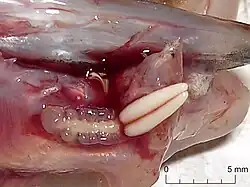Acanthochondria limandae
| Acanthochondria limandae | |
|---|---|

| |
| Female Acanthochondria limandae attached to Limanda limanda. The two white cylindrical objects are its egg sacs. | |
| Scientific classification | |
| Kingdom: | Animalia |
| Phylum: | Arthropoda |
| Class: | Copepoda |
| Order: | Cyclopoida |
| Family: | Chondracanthidae |
| Genus: | Acanthochondria |
| Species: | A. limandae
|
| Binomial name | |
| Acanthochondria limandae (Krøyer, 1863)
| |
| Synonyms[1] | |
|
Chondracanthus limandae Krøyer, 1863 | |
Acanthochondria limandae is a species of copepods in the family Chondracanthidae.[1] They are host-specific ectoparasites of two species of flatfish: the common dab (Limanda limanda) and the European flounder (Platichthys flesus). They attach themselves to the bases of the gill arches of their hosts. They can infest as much as 2 to 30% of fish in a given population.[2]
Acanthochondria limandae was first described by the Danish zoologist Henrik Nikolai Krøyer in 1863 as Chondracanthus limandae.[1]
References
- ^ a b c Walter TC, Boxshall G, eds. (2024). "Acanthochondria limandae (Krøyer, 1863)". World of Copepods Database. World Register of Marine Species. Retrieved 6 April 2024.
- ^ Kabata, Z. (1959). "Ecology of the genus Acanthochondria Oakley (Copepod, Parasitica)". Journal of the Marine Biological Association of the United Kingdom. 38 (2): 249–261. Bibcode:1959JMBUK..38..249K. doi:10.1017/s0025315400006056.